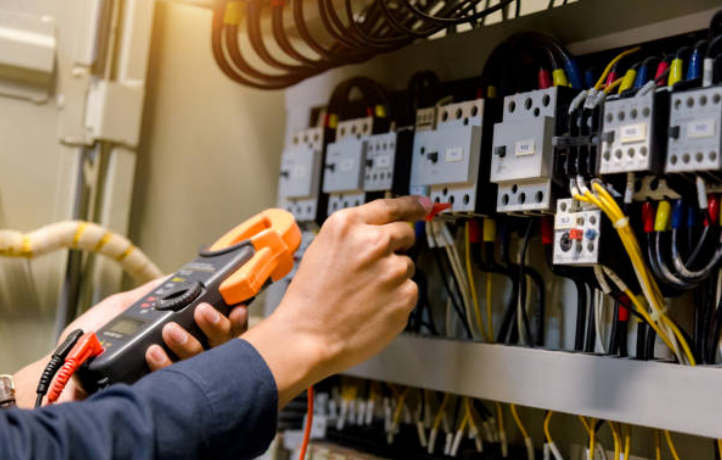Residential Commercial Electrical Installations Repairs And Upgrades
by siteadmin

Residential electrician work is performed in homes and can include everything from repairing wall outlets to installing chandeliers. Homeowners who want to improve their electrical systems can also take advantage of services like service panel upgrades, lighting upgrades, and electric car charging stations installation. These improvements can make the property safer, more energy efficient, and increase its value.
Romex Cables
When wiring a commercial building, there are a variety of different types of wires available. Some are rated for use underground or indoors, while others are designed for high-heat applications. Some are made of copper while others are tin-coated to resist wear and tear. Choosing the right wire for your needs is critical to ensuring a safe and functioning electrical system.
The most common type of wire used in commercial buildings is nonmetallic sheathed cable, or NM (pronounced romex) wire. These cables consist of insulated conductors in a plastic sheath that can be run through walls and attics. They are typically categorized by the National Electric Code (NEC) and numbered in accordance with their gauge. Typically, NM wires will have two insulated conductors and a bare grounding wire.
Unlike extension cords, these wires are intended for permanent wiring in residential and commercial buildings. However, they should not be used as a substitute for appliance wiring or as a way to extend the life of an existing extension cord. It is important to always check with local laws before using NM wires. Some communities may never allow them and require the use of armored cables instead.
Before beginning a residential or commercial wiring project, you must ensure that the installation meets NEC and local requirements. The most common mistake is using NM wire where it is not permitted, such as above drop ceilings or in wall cavities. This is a serious safety issue and can lead to fires or electrical failure.
In addition to checking the NEC and local rules, you must also make sure that your NM wires are properly supported and secured. This can help prevent excessive movement that could loosen connections and cause damage to the wires. It is also a good idea to wrap the ends of each wire in duct tape to further protect them.
To splice a Romex wire, you must first strip back the outer insulation to expose the inner strands of wires. Then, using electrician’s pliers, twist the strands of the wire together. For example, if you are connecting 12/2 Romex with a ground, you will connect the black wire to the white and the white to the black. Next, use a wire nut to secure the joint.
Sub-Panel Wiring
The electrical panel is the central point of your home’s power distribution. It contains fuses and circuit breakers that stop the flow of electricity when there’s an overload. The panels are designed to protect your appliances, but over time they may become worn or need to be replaced. In addition, they may require a repair or upgrade to meet current safety standards and codes.
A sub-panel is a smaller panel that’s installed to distribute power in a specific area of the home or business. They are typically used for new construction, remodeled spaces, and adding an additional suite to a property. This allows the homeowner or business owner to add more circuits without straining the main electrical panel.
In some cases, older homes in need to have their electrical systems upgraded. Modern electronics, 4k TVs, and premium sound systems can put a lot of demand on your system. If your home has an 80 amp panel, you might need to have it upgraded to a 200-amp service. A 200-amp upgrade is a significant investment, and it requires replacing the entire panel, lever bypass meter, and new or updated grounding.
If you’re thinking about a residential electrical sub panel, you should talk to an electrician to see if it’s a good idea for your home or business. Sub panels can be installed for a variety of reasons, including increasing capacity, improving safety, and separating circuits.
It’s also a good idea to have your sub-panel inspected by an electrician regularly to make sure everything’s in working order. This will prevent issues with the breaker box from occurring, and it will help keep your energy costs low.
If you’re looking to upgrade your electrical system, we can help. Our professional electricians are licensed and insured to perform any necessary repairs or upgrades to your electrical panel, breaker box, and wiring. Contact Ampi Electric Inc. today for a free quote on your project. Our electricians are happy to provide you with a safe and reliable electrical system that’s built to last. We offer competitive rates for both residential and commercial projects, and our service is second to none.
Circuit Breaker Panels
Your electrical panel is what connects your home to the grid. It is the main distribution point for all of your electrical outlets, lights, heaters, and appliances. Electricity comes into the breaker box via what is called a service drop (from buried power lines or poles) and from there it is redistributed throughout your home by circuits. The breaker box also houses safety devices known as circuit breakers. If a certain part of the house draws too much electricity and causes an overload, the breaker will trip and cut off the flow of electricity. The breaker switches in the breaker box are usually labelled with their amperage ratings and which parts of the house they control.
If you are experiencing a lot of breaker trips, or your electrical outlets are warm to the touch or show burn marks, it may be time to replace your breaker panel. Upgrading your breaker panel will ensure that there is enough power available for your household and that it will be safe for all of your electrical devices.
Most residential breaker panels are located in an out-of-the-way location like the basement, laundry room, or garage. They look like a metal box in the wall that is filled with switches. Some homes have a main breaker panel, while others have subpanels connected to the main breaker panel that are used for areas of the home such as a separate rental suite or an outbuilding.
If you are looking to replace your breaker panel, it is important that you hire an electrician with experience installing electrical panels and has the right tools and equipment for the job. They should be licensed and insured to work on your home's wiring. It is also a good idea to get three different quotes to compare prices and services. An electrician with the proper tools and experience will be able to install your new breaker panel quickly and efficiently. They will also be able to advise you on what size breaker panel is best for your home. An electrical panel that is too small will cause too many breaker trips, while an overly large breaker panel can be dangerous and difficult to manage.
Electrical Devices
Electrical devices are the items in your home that use electricity, like overhead light fixtures and electric outlets on the walls. They are also the devices you plug into those outlets, including appliances like your hair dryer and dishwasher. Power travels through these devices by way of one or more device circuits, which may be single-device circuits that power a single outlet or multiple-device circuits that power a group of outlets, switches, and fixtures.
These circuits are the lifeline of your home and should be well-maintained, especially since any problems with them can affect everything you use electricity for. The most common problem is when one or more of these devices are overloaded, but this can be prevented by properly evaluating the load on each device and limiting how much energy each uses.
Most of the electrical devices in our homes work on high voltages (230V AC, 440V AC, etc). They usually convert electric current into other forms of energy that we can consume such as heat, motion, or light. Examples of these electrical devices include electric fans and lights, heaters, irons, motors, transformers, and other household appliances.
Electronic devices, on the other hand, process and manipulate data. They also have the ability to sense and respond to changes. Examples of these are sensors, computers, mobile phones, and televisions.
Though both electrical and electronic devices require electric current to function, they are different in their size and operations. Electrical devices have components like copper and aluminum, which conduct electricity, whereas electronics are made of semiconductor materials such as silicon and germanium. Also, the electrical devices are mostly passive elements, but the electronic devices have both active and passive elements. This makes the maintenance or repairing of electrical devices easy, but it is difficult to find faults in electronic devices. Both devices require regular checkups by a professional electrician to prevent any electrical issues. A professional from electrician fort lauderdale can identify the issue and repair it before it becomes a bigger problem. This can save you a lot of money in the long run. In addition to this, it will ensure that your home or business is safe from potential accidents.
Residential electrician work is performed in homes and can include everything from repairing wall outlets to installing chandeliers. Homeowners who want to improve their electrical systems can also take advantage of services like service panel upgrades, lighting upgrades, and electric car charging stations installation. These improvements can make the property safer, more energy efficient, and…
Recent Posts
- Abilene Electricians: Setting the Standard for Excellence in Electrical Services
- Abilene Electricians: Setting the Standard for Excellence in Electrical Services
- Eco-Friendly Power: How Solar Panels Are Changing the Game in NT
- Eco-Friendly Power: How Solar Panels Are Changing the Game in NT
- Driving the Future: Exploring the Advancements in Electric EV Technology
